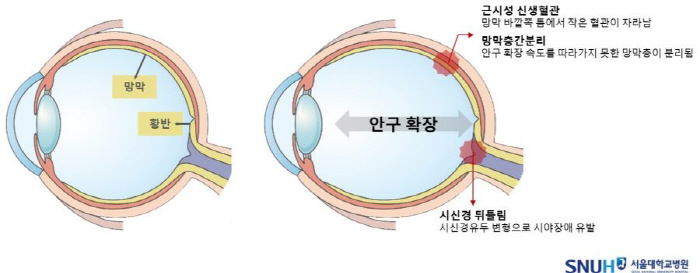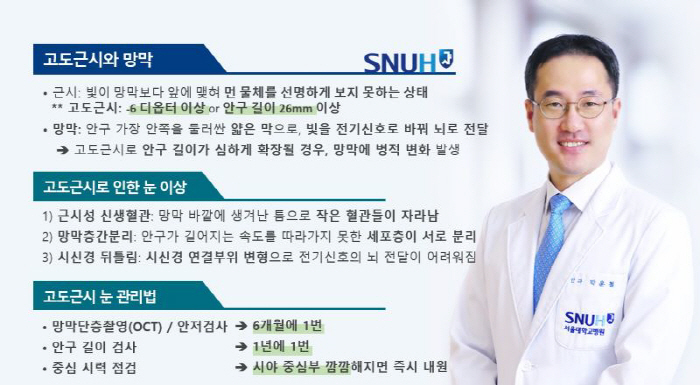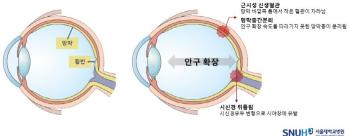Suddenly, it's dark in front of me...high myopia, a red flag for retinal health
Oct 09, 2025
|
While these environments provide convenience, they can pose a serious threat to our eye health.
The eyes maintain vision by systematically functioning various structures.
In the meantime, the retina, which acts as a high-performance sensor for our eyes, is a sophisticated tissue with more than 100 million cells intertwined, just like the name 'Net membrane (網膜)'. It surrounds the innermost part of the eyeball and plays an important role in recognizing light, converting it into electrical signals, and transmitting it to the brain.
However, high myopia can cause changes in the retinal structure, leading to irreversible vision damage. The prevalence of nearsightedness is increasing worldwide, and the prevalence is higher, especially in East Asia, requiring more attention. The effects of high myopia on the retina and appropriate eye health care methods were investigated with Professor Park Un-cheol of Seoul National University Hospital.
◇ What are the criteria for high myopia?
Myopia is a state in which light entering the eye is formed in front of the retina, making it impossible to clearly see objects far away. It is classified as a diopter representing the number of glasses, and is generally classified as highly nearsighted from when it is more than -6 diopter or more than 26 mm in eyeball length.
◇ How does high myopia affect the retina?
Patients with only refractive power during high myopia can correct their vision with glasses or lenses, but patients with severely elongated eyes can be affected by the retina and the macula, the center of the retina, and may be accompanied by pathological vision abnormalities (melanopathy). Just as the bigger the balloon is, the thinner the surface and the easier it is to burst, if the eyeball expands abnormally, the retina weakens and becomes more vulnerable to damage or aging. In a broad sense, it is a type of macular degeneration, but the cause and progression pattern are different from age-related macular degeneration that commonly occurs in the elderly.
◇ Representative changes due to high myopia?
First of all, myopic neovascularization occurs. As the eyeball expands, there is a gap in the outer tissue of the retina, and small blood vessels grow in between. These new blood vessels can cause bleeding or exudate, which can reduce vision, and if the blood vessels regress over time, large atrophy can occur in the center of the retina, resulting in a central dark spot in the middle of the field of view. Early diagnosis and treatment are important to minimize macular damage, and are treated by injecting vascular endothelial cell growth factor (VEGF) inhibitors into the eyeball.
There is also a separation between retinal layers. If the tissue fails to keep up with the rate of increase in the eyeball, the cell layers that make up the retina are separated from each other. When this symptom invades the center of the macula, vision deteriorates, and if it gets worse, a hole (a macular hole) may form in the middle of the retina and eventually the retinal tissue may fall out of place (retinal detachment). As a result, if it is determined that the separation of the retinal layers continues to have a significant effect on vision, a high-level operation is required to reattach the cracked or fallen retinal tissue.
In addition, optic nerve distortion can occur. Stretching the back of the eyeball can deform the optic nerve connection site (optic nipple), which can cause problems in optic nerve connection, leading to visual impairment. For treatment, an intraocular pressure lowering agent is administered to protect the nerves and prevent visual impairment.
◇ anyone else is prone to high myopia maculopathy?
It occurs mainly in those in their 40s or older, and women are more common than men. In addition, among patients with high myopia, those who do not stop structural changes such as increased eye length and progress slowly for a long time can develop maculopathy in their 60s and 70s, even if the retina and macular function are normal in their 40s and 50s.
◇ Can macular disease in high myopia be cured?
Unfortunately, the method of preventing the abnormal expansion of the eyeball itself is not yet known. However, secondary complications caused by ocular expansion of the eye at high myopia, such as neovascularization and retinal interlayer separation, can be sufficiently treated through injection or surgery. Therefore, it is most important not to miss the timing of treatment through regular checkups.
◇ What kind of care is high myopia patients?
High myopia patients should pay special attention to their eye health. It is especially important not to miss the change in vision. To this end, it is recommended to undergo retinal tomography (OCT) and fundus examination from a specialist at least every six months, and observe an increase through an eye length examination about once a year. In addition, if the middle of the field of vision suddenly becomes invisible or dark, you should not delay and seek medical attention from a retinal specialist.
Professor Park Un-cheol of the Department of Ophthalmology at Seoul National University Hospital emphasized that "The retinal membrane is a thin nerve membrane composed of numerous visual cells and blood vessels, which can lead to visual and visual impairment with only a small structural and functional change, which is directly related to the quality of life, so it requires a lot of attention and attention.'
In addition, in addition to "high myopia, various retinal diseases such as macular degeneration, diabetic retinopathy, and retinal detachment can cause vision loss, but with the development of technology and new drugs, effective treatment is often possible unlike before. Therefore, if you have symptoms such as decreased vision or visual impairment, you need to get medical attention quickly, and non-epithelial diseases that seem to be floating in dust or small bugs, and optometriosis that flash in front of your eyes can also be signs of retinal diseases, so it must be confirmed. Because you have two eyes, the disease often occurs without your knowledge, and I hope you don't miss the time to detect and treat the disease early through regular ophthalmic examinations. "
|
This article was translated by Naver AI translator.














